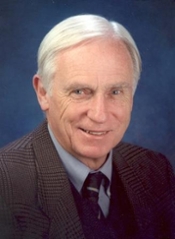

|

|
IN MEMORIAM
Rodney H. Withers
Professor of Radiation Oncology
UC Los Angeles
1932 - 2015
“Rod” Withers, M.D., Ph.D., AO (b. 1932) peacefully passed away at his Houston home on February 25th 2015 surrounded by his wife Janet, Daughter Genevieve, and granddaughters Sarah and Emma.
For about 4 decades, Rod Withers stood as the pre-eminent role model for translational research astride radiation biology and radiation oncology. He was born in Stanthorpe, Queensland and did his medical training at the University of Queensland specializing in Pathology and Radiology before going to London University to become what he used to say was the first and last Ph.D. student of the famous “Hal” Gray. Here, in the early 1960s, he used a mouse skin model to develop the first in situ stem cell cloning technique to measure radiation responses. After his Ph.D., he returned briefly to Australia before taking up a position in 1966 as a Visiting Resident Scientist at the National Cancer Institute in Bethesda, Maryland. Here, he worked with Mort Elkind, with whom in 1998 he received the highly prestigious General Motors Cancer Research Foundation Award and Charles F. Kettering Medal. Together they developed the in situ mouse jejunal crypt stem cell assay and used it to dissect the basic radiobiological principles that underlie clinical dose fractionation. After 2 years, he moved to the M.D. Anderson Hospital and Cancer Clinic under Herman Suit and Gilbert Fletcher working with long-time colleague Kathy Mason and later Lester Peters at the Experimental Division where he stayed until 1980. During this critical period, Rod continued to investigate the dose-time relationships fractionated radiation delivery that he enshrined in 1975 in his famous 4Rs – repair, repopulation, redistribution, and reoxygenation - that have guided clinical radiation oncology practice ever since. The hallmark of this seminal research was its emphasis on quantitation of radiation effects through a highly productive collaboration with Howard Thames. They brought the linear quadratic formulation into common use as the model to change total dose when changing fraction size. Importantly, they spotlighted the hugely important concept that different normal tissues respond differently to change in fraction size and that late responding normal tissues, but not most tumors, were spared by low dose fractionation, which results in the therapeutic advantage from fractionation.
In 1980, Rod joined the Department of Radiation Oncology, University of California at Los Angeles, under Bob Parker, from whom he took over as Chair from 1994-2005. Early on, he invited Jasek Maciejewski to visit from Gliwice, Poland, and together with Jeremy Taylor they quantified the effects of accelerated tumor repopulation in head and neck cancer during fractionated radiation therapy, stressing the dangers inherent in prolonging treatment time, another clinically-relevant critical concept.
Rod’s clarity of thought on the time-dose issues in radiation therapy enabled him to propose how altered fractionation schemes, as in hyper-, hypo- and accelerated fractionation, might be of clinical value and to predict the size of the benefit using the linear quadratic model. This led to two pivotal phase III clinical trials in Europe led by Jean-Claude Horiot that illustrated how accurate Rod’s predictions were as to the effects of hyper- and accelerated fractionation. Many more similar trials were conducted around the world, including the introduction of the “concomitant boost” technique at the M.D. Anderson by Lester Peters.
Rod spent a spell as Professor and Director of the Institute of Oncology at the Prince of Wales Hospital/University of NSW, Australia, in 1989-91, and as interim Director of the Jonsson Comprehensive Cancer Center at UCLA 1994-1995. He was appointed an American Cancer Society Clinical Professorship in 1992. He has been given practically every honor possible in his field. The medal list alone includes the Radiation Research Society Failla Award and Gold Medal (1988), The ASTRO Gold Medal (1991), the Kaplan Award (1991), The Gray Medal (1995), the D.O.E Fermi Award (1997), The Charles F. Kettering Medal (1998), The Polish Oncology Gold Medal (2002), The Belgian Radiation Oncology Society Emmanuel van der Schueren Medal (2004), American College of Radiology Gold Medal (2004), The Gilbert H. Fletcher Society Gold Medal (2005), and the Radiological Society of North America Gold Medal (2005).
Rod Withers was the pre-eminent clinically oriented radiation biologist in the world. He was a translational researcher before the term was widely acknowledged. As such, he has left a huge imprint on both basic and clinical radiation research. He was one of the first stem cell biologists and the highly quantitative work stem cell assays he carefully developed starting over 50 years ago, combined with the clarity of his vision, have explained many clinical phenomena involving time/dose relationships and fractionation in radiation cancer therapy. His teachings have had a major impact on the way radiation oncology is practiced. This charismatic character and inspirational leader will be sorely missed.
Michael Steinberg, MD, Professor and Chair